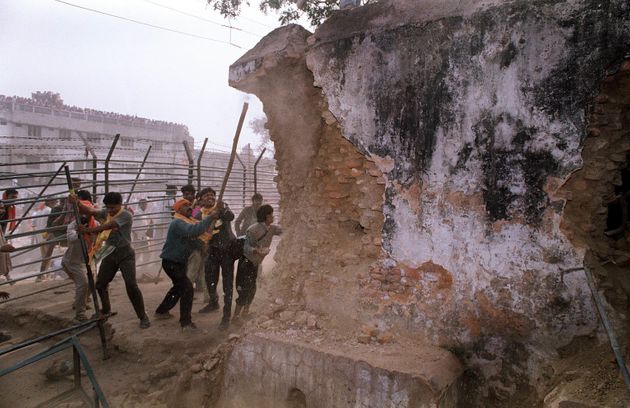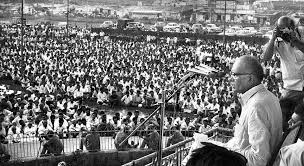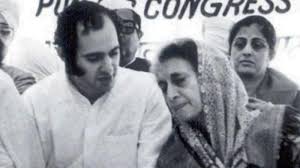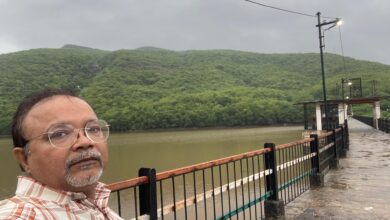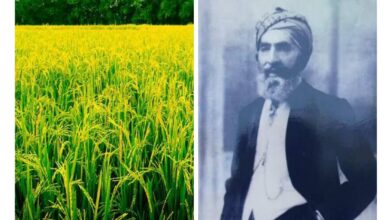Babri Masjid : why CBI Couldn’t Prove A Crime
we must have an independent prosecution agency
A court has acquitted all accused in Ayodhya Babri Mosque demolition case .Constitutional expert and law professor Faizan Mustafa points out how the Babri Masjid destruction case was scuttled from the very beginning.
Close to 30 years after the Babri Masjid was demolished in Ayodhya, a special court set up by the Central Bureau of Investigation (CBI) acquitted 32 of the 49 accused who are still alive, including Bharatiya Janata Party (BJP) veteran leaders L.K. Advani and Murli Manohar Joshi.
The CBI Judge S.K. Yadav ruled there was no pre-planned conspiracy to demolish the 16-century mosque, despite extensive documentation establishing that hundreds of thousands of karsevaks came to Uttar Pradesh and were instigated by prominent leaders of the Hindu right.
Speaking with HuffPost India, Faizan Mustafa, Vice Chancellor of NALSAR University of Law, said he had eight “unusual” things to point out about the Babri Masjid demolition case from start to finish.
“With 351 witnesses, the CBI could not convince a judge about a crime that the entire world was a witness. That does not speak very highly of the rule of law,” Mustafa said.
The following excerpts have been lightly edited for clarity.
Ayodhya The Beginning, December 1992
You had one incident in Ayodhya on 6 December, 1992 and two FIRs were filed within a gap of ten minutes. The two FIRs talk of different crimes. The first FIR is an unnamed FIR. It says some people demolished Babri Masjid. A second FIR is filed within ten minutes, naming certain people like Ashok Singhal, Uma Bharti, Murli Manohar Joshi, L.K Advani, Vishnu Hari Dalmia, etcetera. Now, the FIR, which is about these top BJP, VHP, Bajrang Dal leaders, did not include the conspiracy offense. And the FIR which was unnamed talked of the conspiracy of demolition. For the same incident, the FIR which is about BJP leaders, is investigated by UP-CID, and the unnamed FIR is given to the CBI. You have two FIRs about one incident. Two different sets of crimes charged. Two different investigating agencies. This is unheard of in a criminal trial. Then, in August 1993, the two FIRs were handed over to CBI and the CBI filed a joint chargesheet in October. One trial started in Rae Bareilly and the other trial started in Lucknow.
Advani’s first discharge, 2003
Then, the V.K. Singh court in Rae Bareilly discharged Advani from conspiracy charges in 2003. When Advani was discharged, and Murli Manohar Joshi was not, Joshi went to the Allahabad High Court against the decision of V.K. Singh and he said I should also be discharged. The High Court, Justice Y.R. Tripathi, quashed Advani’s discharge and he said that the conspiracy charges were for everyone.
Nothing happens
For seven years, nothing happened. In 2011, the CBI came to the Supreme Court but nothing happened for another six years. In 2017, Justice R.F Nariman says this trial should be completed — it is such a big crime and an assault on secularism. And then, this judge (Yadav) is asked to give a decision by 2019. He does not do it and he retires. And then the Supreme Court says his tenure in service should be extended till he gives judgment. So, he retires today (30 September).
What was the problem?
It was not progressing because there was a technical defect. When a CBI court is constituted, the High Court should be consulted. In one FIR, the High Court was not consulted. And therefore Justice Jagdish Bhalla of the Allahabad High Court pointed out that I’m quashing it because it has a technical defect. In three places in his judgment, he says this defect is curable. In the middle, you had Mulayam Singh Yadav, Akhilesh Yadav, Mayawati — all swearing into secularism, why did they not cure the defect?
In 2017, the Supreme Court invoked its extraordinary powers under Article 142 of the Indian Constitution that allows it to pass any order to deliver “complete justice.” It cured the defect and said now go and have a trial. Justice Nariman, quoting British judge Lord Mansfield, said, “Let justice be done though the heavens fall.”
Criminal law
I understand that in criminal law, the presumption of innocence is in favour of the accused, the burden of proof on the prosecution is very heavy, and the prosecution has to prove the case beyond a shadow of doubt. If there are cracks in the prosecution story, the benefit will go to the accused.
But in my opinion, it is people’s faith in the rule of law that is at stake. And if by some judgment that faith gets shaken then it is a challenge for any constitutional democracy. In this case, people saw on TV that a mosque was razed and brought to the ground. It was unprecedented. Temples, mosques and churches were destroyed during the ancient and medieval period by monarchs. You did not have rule of law, democracy, a Constitution, or a judicial system. It was for the first time that on Sunday afternoon, we were watching on TV, mobs destroying someone’s religious place.
The UP (BJP) government Chief Minister (Kalyan Singh) gave 11 affidavits to the Supreme Court, assuring the court that the disputed structure will not be destroyed. Till date, the Supreme Court has not punished Kalyan Singh for contempt of court but Prashant Bhushan was punished within months.
The Supreme Court did not read the situation well. And when the mosque was demolished, the court expressed its regret. Had the Supreme Court stopped karseva, as was requested by the Attorney General of India (Milon K Banerjee) and by several Muslim petitioners, this tragedy that tarnished India’s image could have been avoided. The Centre (Congress Party) did not impose President’s Rule despite all the intelligence inputs. Finally, this historic mosque was demolished.
The charges
What are the charges? One charge is that you made provocative speeches.
The record of those speeches — in Ayodhya and elsewhere — are fully available. Then, there is a very clear case of an unlawful assembly. Mere membership is punishable. Whether anyone in the crowd, whether Advani or Joshi, demolished or did not demolish is irrelevant. Were they part of an unlawful assembly? The answer is yes. If they were in the prosecution of a common object, then definitely this is a case where they should be found guilty.
Justice Liberhan Commission
I’m reading these slogans from the Allahabad High Court judgment dated July 6, 2005 — “Ek dhakka aur do, Babri masjid tod do,” “Tail lagao Dabur ka, naam mitao Babur ka.” Sadhvi Rithamabara said from the dias, “Jai Shri Ram, ho gaya kaam.”
What is this kaam or work? The kaam was the completion of the demolition.
The whole case is that there was a pre-planned conspiracy to demolish the mosque and this was made out by the Justice Liberhan Commission report. But Sadhvi Rithambara has been acquitted today. And Uma Bharthi, who is reported to have said that we have done the job, now it is your job to keep the lotus blooming. That shows political, not just religious motivations. Then, Acharya Dharmendra told people that if you have not got prasad, to take the bricks of the mosque. All this, in my opinion, shows that there was a common object and they were all members of an unlawful assembly, they indulged in rioting and provocative speeches. They were tried for these very offences.
Conclusion
With 351 witnesses, the CBI could not convince a judge about a crime that the entire world was a witness. That does not speak very highly of the rule of law. In a case like this, when the crime is huge, and the judges say, ‘Let justice be done though the heavens fall,’ I’m surprised why the CBI was not able to convince the judge.
The CBI works under the Union Home Ministry. If we want to improve our criminal justice system, we must have an independent prosecution agency like we have in the western world. Investigation and prosecution cannot be in the same hands. Like the British system, there should be an independent directorate of prosecution, which should prosecute in appropriate causes after investigation by the police.
By Betwa Sharma , Politics Editor, HuffPost India

